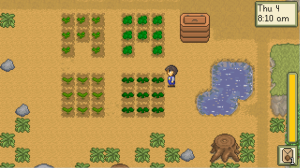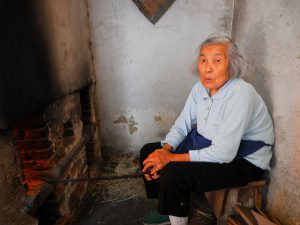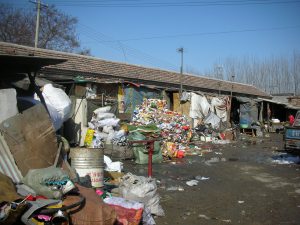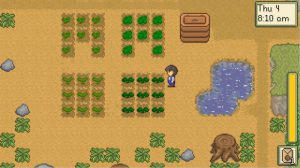As ever increasing numbers of us move to cities, people today seem to have nostalgia for villages that no longer exist. Stardew Valley, an American indie farming game that was recently released in Chinese, shows that sentiment expressed in computerised form.
In this virtual setting the protagonist quits the bustle of the city for a simple life on a farm. It’s an idea that strikes a chord with young people in China’s metropolises of Beijing, Shanghai and Guangzhou.
Urban focus
As a form of media, video games have tended to overlook rural life. There are few that are set in villages and when they are featured it is usually as a flimsy backdrop, with any cultural significance hollowed out.
The language of games is urban. The stories they tell are set in cities and are based around the jobs, relationships and lifestyles of people living in them. Villages are seen as subordinate and either ignored altogether or made into battlefields, ruins or extensions of the city.
Villages then are seen as unimportant, unsafe and as places to flee, whereas cities are flourishing hubs that offer safety and hope.
Stardew Valley manages to rebel against this city-centricity of the video game industry. Set on a dilapidated farm once owned by the player’s grandfather, it challenges the assumption that urban life means “progress” and rejects it for its association with exploitation, alienation, and oppression. Meanwhile village life is affirmed as humane, warm, and nurturing of the individual. The downshifting protagonist tills his fields, plants seeds, and harvests happiness.
Idealised rural life
The game’s opening portrays you, the player, as an average urban worker, monitored by the powerful and spending your time either in a state of work or rest.
As one small cog in a huge machine you come to realise the true nature of urban living and working, which is characterised by alienation. But one day you inherit your grandfather’s farm and decide to end your suffering and go in search of joy.
You quit the city for a small home by the sea, where you farm, fell wood, mine, fish, raise livestock and trade, allocating your labour as you see necessary. And as you do so, you discover the warmth you lacked for so long. Your neighbours are friendly and help you settle into your new life and occasionally present you with gifts of their own produce. Over time your soul heals and you decide to settle, start a family and enjoy a happy rural life.
A letter from your grandfather explains the Stardew Valley philosophy: when modern life is suffocating you, find the real meaning of life in the village. This is the alterative mode of living that the game presents, painting a warm, romantic portrait of rural life.
But reality is not that simple. In "The Country and the City in the Modern Novel", author Raymond Henry Williams points out that literature tends to beautify pastoral life. But the picturesque villages are themselves products of romanticism and nostalgia, betraying the overly simplistic thinking of society. In reality, powerful interests and capital have always roamed at will between city and village.
The game’s developer is acutely aware of the potential crises facing modern villages and communicates these to the player. Urban capitalists, such as the “Joja Company”, are at work in the village threatening the way of life.
Two different ideologies are at war, and we must choose between them. An urbanised village means an easier life, but is also one that pollutes the environment and the locals’ souls. A bucolic farming community means back-breaking toil but also contentment.
Interestingly, Stardew Valley’s development was itself a reaction against corporate efficiency-driven methods of working in favour of artisanship. The game was designed, programmed, drawn and scored by a young Seattle man, Eric Barone, who worked on it for over ten hours a day for four years. And what appears on your screen is not dazzling 3D effects but low-resolution graphics more redolent of an 8-bit Nintendo.
More than a game
Stardew Valley’s narrative clearly reflects the author’s own thinking. Barone, a programmer working in the city, took his views about urban life and designed a game around these to communicate his ideas to others. We can infer that the author reflected his views on the relationship between city and country into the game as an attempt to give the game a social function. And more – during the game players must make choices, turning the developer’s hints into action. The fundamental question is how to take that understanding and turn it into a set of real-life actions.
Games are a virtual extension of ourselves in which the player moves and achieves some goal in a virtual world. Meanwhile we are unconscious of our actual bodies, which are less under our control. Stardew Valley provides what might be an imaginary, not adequately “real” rural experience that lacks in complexity and reality. Such inadequately “real” experiences may be very dangerous.
Playing a game doesn’t mean you really understand the villages or have really experienced rural life – perhaps all it does is create or strengthen a lack of coordination between mind and body. Barone set out to design a game and raise issues. Perhaps the real significance comes when the game finishes: if the player turns off the power and walks into the countryside to accept what nature has to offer, and takes real action to combat capitalism’s attempts to separate us from it. Perhaps that is the real significance of Stardew Valley.
This article was originally published on Tootopia.me, a content cooperative.






![Arctic ice continues to melt, we must approach the challenge with some hope [image by: NASA/Kathryn Hansen]](https://dialogue.earth/content/uploads/2017/04/Arctic-ice-NASA-300x200.jpg)

